[English] 日本語
 Yorodumi
Yorodumi- EMDB-7785: Cryo-EM structure of a Plasmodium vivax invasion complex essentia... -
+ Open data
Open data
- Basic information
Basic information
| Entry | Database: EMDB / ID: EMD-7785 | |||||||||
|---|---|---|---|---|---|---|---|---|---|---|
| Title | Cryo-EM structure of a Plasmodium vivax invasion complex essential for entry into human reticulocytes; two molecules of parasite ligand, subclass 2. | |||||||||
 Map data Map data | Structural insight into specificity of human malaria parasite Plasmodium vivax towards reticulocytes; two molecules of parasite ligand, subclass 2. | |||||||||
 Sample Sample |
| |||||||||
 Keywords Keywords | malaria / Plasmodium vivax / reticulocyte / invasion / CELL INVASION | |||||||||
| Function / homology |  Function and homology information Function and homology informationtransferrin receptor activity / postsynaptic recycling endosome membrane / negative regulation of mitochondrial fusion / iron chaperone activity / transferrin receptor binding / Transferrin endocytosis and recycling / positive regulation of isotype switching / basal part of cell / response to manganese ion / Differentiation of Keratinocytes in Interfollicular Epidermis in Mammalian Skin ...transferrin receptor activity / postsynaptic recycling endosome membrane / negative regulation of mitochondrial fusion / iron chaperone activity / transferrin receptor binding / Transferrin endocytosis and recycling / positive regulation of isotype switching / basal part of cell / response to manganese ion / Differentiation of Keratinocytes in Interfollicular Epidermis in Mammalian Skin / response to iron ion / RND1 GTPase cycle / RND2 GTPase cycle / response to copper ion / RHOB GTPase cycle / Golgi Associated Vesicle Biogenesis / RHOC GTPase cycle / RHOJ GTPase cycle / RHOQ GTPase cycle / CDC42 GTPase cycle / RHOH GTPase cycle / RHOG GTPase cycle / RHOA GTPase cycle / endocytic vesicle / RAC2 GTPase cycle / RAC3 GTPase cycle / response to retinoic acid / regulation of postsynaptic membrane neurotransmitter receptor levels / transport across blood-brain barrier / positive regulation of B cell proliferation / positive regulation of T cell proliferation / clathrin-coated pit / RAC1 GTPase cycle / response to nutrient / Hsp70 protein binding / ferric iron binding / osteoclast differentiation / basal plasma membrane / cellular response to leukemia inhibitory factor / transferrin transport / acute-phase response / cellular response to iron ion / Post-translational protein phosphorylation / iron ion transport / clathrin-coated endocytic vesicle membrane / positive regulation of protein-containing complex assembly / ferrous iron binding / regulation of iron ion transport / Iron uptake and transport / HFE-transferrin receptor complex / recycling endosome / regulation of protein stability / positive regulation of receptor-mediated endocytosis / receptor internalization / positive regulation of protein localization to nucleus / multicellular organismal-level iron ion homeostasis / cellular response to xenobiotic stimulus / Regulation of Insulin-like Growth Factor (IGF) transport and uptake by Insulin-like Growth Factor Binding Proteins (IGFBPs) / recycling endosome membrane / melanosome / antibacterial humoral response / late endosome / Platelet degranulation / positive regulation of proteasomal ubiquitin-dependent protein catabolic process / Cargo recognition for clathrin-mediated endocytosis / double-stranded RNA binding / extracellular vesicle / Clathrin-mediated endocytosis / virus receptor activity / cytoplasmic vesicle / secretory granule lumen / blood microparticle / basolateral plasma membrane / vesicle / intracellular iron ion homeostasis / transmembrane transporter binding / response to hypoxia / early endosome / positive regulation of canonical NF-kappaB signal transduction / endosome / endosome membrane / intracellular signal transduction / apical plasma membrane / endoplasmic reticulum lumen / external side of plasma membrane / intracellular membrane-bounded organelle / positive regulation of gene expression / protein kinase binding / negative regulation of apoptotic process / protein-containing complex binding / perinuclear region of cytoplasm / glutamatergic synapse / enzyme binding / cell surface / protein homodimerization activity / extracellular space / RNA binding / extracellular exosome / extracellular region / identical protein binding Similarity search - Function | |||||||||
| Biological species |  homo sapiens (human) / homo sapiens (human) /  Homo sapiens (human) / Homo sapiens (human) /  | |||||||||
| Method | single particle reconstruction / cryo EM / Resolution: 3.8 Å | |||||||||
 Authors Authors | Gruszczyk J / Huang RK | |||||||||
 Citation Citation |  Journal: Nature / Year: 2018 Journal: Nature / Year: 2018Title: Cryo-EM structure of an essential Plasmodium vivax invasion complex. Authors: Jakub Gruszczyk / Rick K Huang / Li-Jin Chan / Sébastien Menant / Chuan Hong / James M Murphy / Yee-Foong Mok / Michael D W Griffin / Richard D Pearson / Wilson Wong / Alan F Cowman / ...Authors: Jakub Gruszczyk / Rick K Huang / Li-Jin Chan / Sébastien Menant / Chuan Hong / James M Murphy / Yee-Foong Mok / Michael D W Griffin / Richard D Pearson / Wilson Wong / Alan F Cowman / Zhiheng Yu / Wai-Hong Tham /    Abstract: Plasmodium vivax is the most widely distributed malaria parasite that infects humans. P. vivax invades reticulocytes exclusively, and successful entry depends on specific interactions between the P. ...Plasmodium vivax is the most widely distributed malaria parasite that infects humans. P. vivax invades reticulocytes exclusively, and successful entry depends on specific interactions between the P. vivax reticulocyte-binding protein 2b (PvRBP2b) and transferrin receptor 1 (TfR1). TfR1-deficient erythroid cells are refractory to invasion by P. vivax, and anti-PvRBP2b monoclonal antibodies inhibit reticulocyte binding and block P. vivax invasion in field isolates. Here we report a high-resolution cryo-electron microscopy structure of a ternary complex of PvRBP2b bound to human TfR1 and transferrin, at 3.7 Å resolution. Mutational analyses show that PvRBP2b residues involved in complex formation are conserved; this suggests that antigens could be designed that act across P. vivax strains. Functional analyses of TfR1 highlight how P. vivax hijacks TfR1, an essential housekeeping protein, by binding to sites that govern host specificity, without affecting its cellular function of transporting iron. Crystal and solution structures of PvRBP2b in complex with antibody fragments characterize the inhibitory epitopes. Our results establish a structural framework for understanding how P. vivax reticulocyte-binding protein engages its receptor and the molecular mechanism of inhibitory monoclonal antibodies, providing important information for the design of novel vaccine candidates. | |||||||||
| History |
|
- Structure visualization
Structure visualization
| Movie |
 Movie viewer Movie viewer |
|---|---|
| Structure viewer | EM map:  SurfView SurfView Molmil Molmil Jmol/JSmol Jmol/JSmol |
| Supplemental images |
- Downloads & links
Downloads & links
-EMDB archive
| Map data |  emd_7785.map.gz emd_7785.map.gz | 3 MB |  EMDB map data format EMDB map data format | |
|---|---|---|---|---|
| Header (meta data) |  emd-7785-v30.xml emd-7785-v30.xml emd-7785.xml emd-7785.xml | 16 KB 16 KB | Display Display |  EMDB header EMDB header |
| Images |  emd_7785.png emd_7785.png | 68.6 KB | ||
| Filedesc metadata |  emd-7785.cif.gz emd-7785.cif.gz | 7.2 KB | ||
| Archive directory |  http://ftp.pdbj.org/pub/emdb/structures/EMD-7785 http://ftp.pdbj.org/pub/emdb/structures/EMD-7785 ftp://ftp.pdbj.org/pub/emdb/structures/EMD-7785 ftp://ftp.pdbj.org/pub/emdb/structures/EMD-7785 | HTTPS FTP |
-Validation report
| Summary document |  emd_7785_validation.pdf.gz emd_7785_validation.pdf.gz | 425.4 KB | Display |  EMDB validaton report EMDB validaton report |
|---|---|---|---|---|
| Full document |  emd_7785_full_validation.pdf.gz emd_7785_full_validation.pdf.gz | 424.9 KB | Display | |
| Data in XML |  emd_7785_validation.xml.gz emd_7785_validation.xml.gz | 5.5 KB | Display | |
| Data in CIF |  emd_7785_validation.cif.gz emd_7785_validation.cif.gz | 6.3 KB | Display | |
| Arichive directory |  https://ftp.pdbj.org/pub/emdb/validation_reports/EMD-7785 https://ftp.pdbj.org/pub/emdb/validation_reports/EMD-7785 ftp://ftp.pdbj.org/pub/emdb/validation_reports/EMD-7785 ftp://ftp.pdbj.org/pub/emdb/validation_reports/EMD-7785 | HTTPS FTP |
-Related structure data
| Related structure data |  6d05MC  7783C  7784C 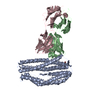 6bpaC 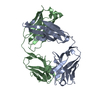 6bpbC 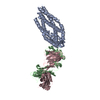 6bpcC 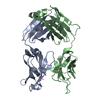 6bpdC 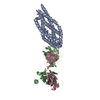 6bpeC  6d03C  6d04C M: atomic model generated by this map C: citing same article ( |
|---|---|
| Similar structure data |
- Links
Links
| EMDB pages |  EMDB (EBI/PDBe) / EMDB (EBI/PDBe) /  EMDataResource EMDataResource |
|---|---|
| Related items in Molecule of the Month |
- Map
Map
| File |  Download / File: emd_7785.map.gz / Format: CCP4 / Size: 22.2 MB / Type: IMAGE STORED AS FLOATING POINT NUMBER (4 BYTES) Download / File: emd_7785.map.gz / Format: CCP4 / Size: 22.2 MB / Type: IMAGE STORED AS FLOATING POINT NUMBER (4 BYTES) | ||||||||||||||||||||||||||||||||||||||||||||||||||||||||||||
|---|---|---|---|---|---|---|---|---|---|---|---|---|---|---|---|---|---|---|---|---|---|---|---|---|---|---|---|---|---|---|---|---|---|---|---|---|---|---|---|---|---|---|---|---|---|---|---|---|---|---|---|---|---|---|---|---|---|---|---|---|---|
| Annotation | Structural insight into specificity of human malaria parasite Plasmodium vivax towards reticulocytes; two molecules of parasite ligand, subclass 2. | ||||||||||||||||||||||||||||||||||||||||||||||||||||||||||||
| Projections & slices | Image control
Images are generated by Spider. | ||||||||||||||||||||||||||||||||||||||||||||||||||||||||||||
| Voxel size | X=Y=Z: 1.35 Å | ||||||||||||||||||||||||||||||||||||||||||||||||||||||||||||
| Density |
| ||||||||||||||||||||||||||||||||||||||||||||||||||||||||||||
| Symmetry | Space group: 1 | ||||||||||||||||||||||||||||||||||||||||||||||||||||||||||||
| Details | EMDB XML:
CCP4 map header:
| ||||||||||||||||||||||||||||||||||||||||||||||||||||||||||||
-Supplemental data
- Sample components
Sample components
-Entire : ternary complex between human transferrin receptor 1, transferrin...
| Entire | Name: ternary complex between human transferrin receptor 1, transferrin and Plasmodium vivax reticulocyte-binding protein 2b |
|---|---|
| Components |
|
-Supramolecule #1: ternary complex between human transferrin receptor 1, transferrin...
| Supramolecule | Name: ternary complex between human transferrin receptor 1, transferrin and Plasmodium vivax reticulocyte-binding protein 2b type: complex / ID: 1 / Parent: 0 / Macromolecule list: #1-#3 / Details: two molecules of parasite ligand, subclass 2 |
|---|---|
| Source (natural) | Organism:  homo sapiens (human) homo sapiens (human) |
-Macromolecule #1: Transferrin receptor protein 1
| Macromolecule | Name: Transferrin receptor protein 1 / type: protein_or_peptide / ID: 1 / Number of copies: 2 / Enantiomer: LEVO |
|---|---|
| Source (natural) | Organism:  Homo sapiens (human) Homo sapiens (human) |
| Molecular weight | Theoretical: 73.940477 KDa |
| Recombinant expression | Organism:  |
| Sequence | String: ADPHHHHHHS SGIEGRGEFR LYWDDLKRKL SEKLDSTDFT STIKLLNENS YVPREAGSQK DENLALYVEN QFREFKLSKV WRDQHFVKI QVKDSAQNSV IIVDKNGRLV YLVENPGGYV AYSKAATVTG KLVHANFGTK KDFEDLYTPV NGSIVIVRAG K ITFAEKVA ...String: ADPHHHHHHS SGIEGRGEFR LYWDDLKRKL SEKLDSTDFT STIKLLNENS YVPREAGSQK DENLALYVEN QFREFKLSKV WRDQHFVKI QVKDSAQNSV IIVDKNGRLV YLVENPGGYV AYSKAATVTG KLVHANFGTK KDFEDLYTPV NGSIVIVRAG K ITFAEKVA NAESLNAIGV LIYMDQTKFP IVNAELSFFG HAHLGTGDPY TPGFPSFNHT QFPPSRSSGL PNIPVQTISR AA AEKLFGN MEGDCPSDWK TDSTCRMVTS ESKNVKLTVS NVLKEIKILN IFGVIKGFVE PDHYVVVGAQ RDAWGPGAAK SGV GTALLL KLAQMFSDMV LKDGFQPSRS IIFASWSAGD FGSVGATEWL EGYLSSLHLK AFTYINLDKA VLGTSNFKVS ASPL LYTLI EKTMQNVKHP VTGQFLYQDS NWASKVEKLT LDNAAFPFLA YSGIPAVSFC FCEDTDYPYL GTTMDTYKEL IERIP ELNK VARAAAEVAG QFVIKLTHDV ELNLDYERYN SQLLSFVRDL NQYRADIKEM GLSLQWLYSA RGDFFRATSR LTTDFG NAE KTDRFVMKKL NDRVMRVEYH FLSPYVSPKE SPFRHVFWGS GSHTLPALLE NLKLRKQNNG AFNETLFRNQ LALATWT IQ GAANALSGDV WDIDNEF UniProtKB: Transferrin receptor protein 1 |
-Macromolecule #2: Serotransferrin
| Macromolecule | Name: Serotransferrin / type: protein_or_peptide / ID: 2 / Number of copies: 2 / Enantiomer: LEVO |
|---|---|
| Source (natural) | Organism:  Homo sapiens (human) Homo sapiens (human) |
| Molecular weight | Theoretical: 77.153906 KDa |
| Sequence | String: MRLAVGALLV CAVLGLCLAV PDKTVRWCAV SEHEATKCQS FRDHMKSVIP SDGPSVACVK KASYLDCIRA IAANEADAVT LDAGLVYDA YLAPNNLKPV VAEFYGSKED PQTFYYAVAV VKKDSGFQMN QLRGKKSCHT GLGRSAGWNI PIGLLYCDLP E PRKPLEKA ...String: MRLAVGALLV CAVLGLCLAV PDKTVRWCAV SEHEATKCQS FRDHMKSVIP SDGPSVACVK KASYLDCIRA IAANEADAVT LDAGLVYDA YLAPNNLKPV VAEFYGSKED PQTFYYAVAV VKKDSGFQMN QLRGKKSCHT GLGRSAGWNI PIGLLYCDLP E PRKPLEKA VANFFSGSCA PCADGTDFPQ LCQLCPGCGC STLNQYFGYS GAFKCLKDGA GDVAFVKHST IFENLANKAD RD QYELLCL DNTRKPVDEY KDCHLAQVPS HTVVARSMGG KEDLIWELLN QAQEHFGKDK SKEFQLFSSP HGKDLLFKDS AHG FLKVPP RMDAKMYLGY EYVTAIRNLR EGTCPEAPTD ECKPVKWCAL SHHERLKCDE WSVNSVGKIE CVSAETTEDC IAKI MNGEA DAMSLDGGFV YIAGKCGLVP VLAENYNKSD NCEDTPEAGY FAVAVVKKSA SDLTWDNLKG KKSCHTAVGR TAGWN IPMG LLYNKINHCR FDEFFSEGCA PGSKKDSSLC KLCMGSGLNL CEPNNKEGYY GYTGAFRCLV EKGDVAFVKH QTVPQN TGG KNPDPWAKNL NEKDYELLCL DGTRKPVEEY ANCHLARAPN HAVVTRKDKE ACVHKILRQQ QHLFGSNVTD CSGNFCL FR SETKDLLFRD DTVCLAKLHD RNTYEKYLGE EYVKAVGNLR KCSTSSLLEA CTFRRP UniProtKB: Serotransferrin |
-Macromolecule #3: Reticulocyte binding protein 2, putative
| Macromolecule | Name: Reticulocyte binding protein 2, putative / type: protein_or_peptide / ID: 3 / Number of copies: 2 / Enantiomer: LEVO |
|---|---|
| Source (natural) | Organism:  |
| Molecular weight | Theoretical: 96.798477 KDa |
| Recombinant expression | Organism:  |
| Sequence | String: GAMGSMHIPI QPSPESTQST NTTDNIDYFD ISDESNYYLI SQLRPHFSNI YFFDEFKRYA SYHTEIKRYE DIHKTKVNSL LNEASRAIG ICNRAKNTVK GLINILENPQ KFKTQRESYD VKLRQYEEKK EAFRGCLLNK NRKNLDQIKK INNEIRDLLE K LKCSQDCQ ...String: GAMGSMHIPI QPSPESTQST NTTDNIDYFD ISDESNYYLI SQLRPHFSNI YFFDEFKRYA SYHTEIKRYE DIHKTKVNSL LNEASRAIG ICNRAKNTVK GLINILENPQ KFKTQRESYD VKLRQYEEKK EAFRGCLLNK NRKNLDQIKK INNEIRDLLE K LKCSQDCQ TNVYFDMIKI YLVDFKKMPY ENYDTFIKQY KNSYLSGVDM IRKIEKQIDN PVTINAIKFT QKEMGYIIDR FE YHLQKVK HSIDQVTALS DGVKPKQVTK NRLKEYYFNI GNYYSIFKFG KDSLNMLNKA LIHKEKIVHN LLGELFGHLE ERI SKLIDS EYFITESNNI ISQSEETLKL AEDVYDKNTK LIEDLTLYPH LEINEFKKDY DNNVEDLRES IIYIQSYVSS IKSA YRYNV LEKDSVESKQ KNIPANSNAQ KKVDELLSII DSISYSNFSV AENFQKMKDY YKEIEKLKIK ILQLIEAIKK YQQHV EELI NKEKAVAILK EDINKIIEYI KGIIEKLKQL ISANKDFDKI FQQVEQLINE ALFNKDQFEH NKNDLHTKMK EIMHTF HER DLQQFLDNMS KFLKDQEASY QNADSKEKLD QLLTTVKAKQ DELKEMKCDD IPDIIDNLKK ESQNVLNLKD EVINKQF EN MRTEMSSSLD QMTKEYNALK SSIEEYEAEK KGIENHKQNI IKRKNTFIVA EHENDEDVPE GKNTYNEFIS NKDTILQK E SAISNQMNTL EEKKRNRKTT LQTYGDAIQK LETYTEKKDE ETKVLLDKFN TEVENFKLDE DEKSFNDAKS IVSNTINEV ENENKNIDSI KKVNIAMKRS UniProtKB: Reticulocyte binding protein 2, putative |
-Macromolecule #5: CALCIUM ION
| Macromolecule | Name: CALCIUM ION / type: ligand / ID: 5 / Number of copies: 2 / Formula: CA |
|---|---|
| Molecular weight | Theoretical: 40.078 Da |
-Macromolecule #6: 2-acetamido-2-deoxy-beta-D-glucopyranose
| Macromolecule | Name: 2-acetamido-2-deoxy-beta-D-glucopyranose / type: ligand / ID: 6 / Number of copies: 4 / Formula: NAG |
|---|---|
| Molecular weight | Theoretical: 221.208 Da |
| Chemical component information |  ChemComp-NAG: |
-Macromolecule #7: FE (III) ION
| Macromolecule | Name: FE (III) ION / type: ligand / ID: 7 / Number of copies: 4 / Formula: FE |
|---|---|
| Molecular weight | Theoretical: 55.845 Da |
-Macromolecule #8: CARBONATE ION
| Macromolecule | Name: CARBONATE ION / type: ligand / ID: 8 / Number of copies: 4 / Formula: CO3 |
|---|---|
| Molecular weight | Theoretical: 60.009 Da |
| Chemical component information | 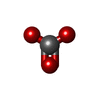 ChemComp-CO3: |
-Experimental details
-Structure determination
| Method | cryo EM |
|---|---|
 Processing Processing | single particle reconstruction |
| Aggregation state | particle |
- Sample preparation
Sample preparation
| Buffer | pH: 7.5 Component:
| ||||||||
|---|---|---|---|---|---|---|---|---|---|
| Vitrification | Cryogen name: ETHANE |
- Electron microscopy
Electron microscopy
| Microscope | FEI TITAN KRIOS |
|---|---|
| Image recording | Film or detector model: GATAN K2 SUMMIT (4k x 4k) / Number grids imaged: 1 / Average exposure time: 15.0 sec. / Average electron dose: 80.0 e/Å2 |
| Electron beam | Acceleration voltage: 300 kV / Electron source:  FIELD EMISSION GUN FIELD EMISSION GUN |
| Electron optics | Illumination mode: FLOOD BEAM / Imaging mode: BRIGHT FIELD |
| Experimental equipment |  Model: Titan Krios / Image courtesy: FEI Company |
- Image processing
Image processing
| Startup model | Type of model: PDB ENTRY PDB model - PDB ID: |
|---|---|
| Final reconstruction | Applied symmetry - Point group: C2 (2 fold cyclic) / Resolution.type: BY AUTHOR / Resolution: 3.8 Å / Resolution method: FSC 0.143 CUT-OFF / Software - Name: RELION / Number images used: 302858 |
| Initial angle assignment | Type: PROJECTION MATCHING |
| Final angle assignment | Type: PROJECTION MATCHING |
 Movie
Movie Controller
Controller






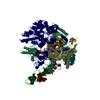





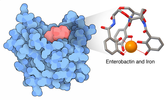




 Z (Sec.)
Z (Sec.) Y (Row.)
Y (Row.) X (Col.)
X (Col.)






















